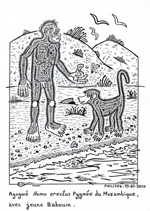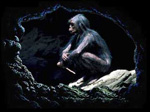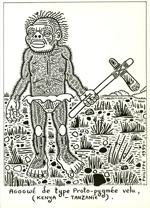
Thought to live in the remote forests of Eastern Africa, the Agogwe is often described as a small, 2 to 5 feet tall, human like biped covered in wooly rust colored hair and having yellowish reddish skin. The creature is often reported to have a rounded forehead, small canines and possessing small feet with an opposable big toe. Though reports are fairly consistent, some describe the Agogwe as having black or grey hair.
The first recorded sighting of the Agogwe by a non African native was documented in 1937 by Captain William Hichens in the December edition of the London magazine Discovery. Describing his 1900 encounter with the Agogwe, Captain Hichens wrote:
“Some years ago I was sent on an official lion hunt in this area,” to which he was referring the Ussure and Simibit forests on the western side of the Wembare plains, “while waiting in a forest glade for a man eater, I saw two small, brown, furry creatures come from the dense forest on one side of the glade and then disappear into the thicket on the other side. They where like little men, about 4 feet high, walking upright, but clad in russet hair. The native hunter with me gazed in mingled fear and amazement. They were, he said, Agogwe, the little furry men whom one does not see once in a lifetime,”  In support of Captain Hichens story, British Officer Cuthbert Burgoyne wrote a letter to Discovery magazine in 1938 recounting his personal sighting of something similar in 1927 while traveling Portuguese East Africa aboard a Japanese cargo boat. Burgoyne wrote:
In support of Captain Hichens story, British Officer Cuthbert Burgoyne wrote a letter to Discovery magazine in 1938 recounting his personal sighting of something similar in 1927 while traveling Portuguese East Africa aboard a Japanese cargo boat. Burgoyne wrote:
“We were sufficiently near to land to see objects clearly with a glass of 12 magnifications. There was a sloping beach with light bush above upon which several dozen baboons where hunting for and picking up shell fish of crabs, to judge by their movements. Two pure white baboons were amongst them. These are very rare but I had heard of them previously. As we watched, two little brown men walked together out of the bush and down among the baboons. They where certainly not any known monkey and they must have been akin or they would have disturbed the baboons. They where to far away to see in detail, but these small human like animals where probably between 4 and 5 feet tall, quite upright and graceful in figure. At the time I was thrilled as they quite evidently no beast of which I had heard or read. Later a friend and big game hunter told me he was in Portuguese East Africa with his wife and three other hunters, and saw mother, father and child, of apparently similar animal species, walk across the further side of a bush clearing. The natives loudly forbade him to shoot.”  The Agogwe is also known as the Kakundakari or Kilomba in Zimbabwe and the Congo Regions of Africa. In the late 1950s, Charles Cordier, a professional animal collector followed the tracks of the Kakundakari in Zaire. Cordier stated that once one of the creatures had become entangled in one of his bird snares. “It fell on it face,” said Cordier, “turned over, sat up, took the noose off its feet, and walked way before the nearby African could do anything.” The Agogwe is also know an the Sehite on the Ivory Coast, the Agogure or Agogue in Tanzania and Northern Mozambique and some researchers suggest that the Orang Pendek of Sumatra may be a related species of the Agogwe.
The Agogwe is also known as the Kakundakari or Kilomba in Zimbabwe and the Congo Regions of Africa. In the late 1950s, Charles Cordier, a professional animal collector followed the tracks of the Kakundakari in Zaire. Cordier stated that once one of the creatures had become entangled in one of his bird snares. “It fell on it face,” said Cordier, “turned over, sat up, took the noose off its feet, and walked way before the nearby African could do anything.” The Agogwe is also know an the Sehite on the Ivory Coast, the Agogure or Agogue in Tanzania and Northern Mozambique and some researchers suggest that the Orang Pendek of Sumatra may be a related species of the Agogwe.
It was suggested by cryptozoologist Bernard Heuvelmans that the Agogwe could be a surviving species of australopithecine, a bipedal primate known to have existed approximately 2.5 million years ago. The description of the Agogwe does fit the known features of the australopithecine, with the exception of Australopithecine’s feet which did have somewhat diverged toe but far from the reported opposable toe of the Agogwe, however over millions of years it is conceivable that this toe may have evolved to become opposable.  Another theory is the possible survival of gibbons in Africa. The gibbon, or lesser ape as it is sometimes called, are different from the so called great apes, chimpanzees, gorillas and orangutans, in that they are smaller, are pair-bonded, do not make nests and in some anatomical details in which they superficially more closely resemble monkeys. While matching the description of the Agogwe, including no tail and having a rounded forehead, gibbons are not known to live in Africa, instead preferring tropical and subtropical rain forests, mainly northeast India, Indonesia and China including the islands of Sumatra, Borneo and Java. Also gibbons rarely walk, instead preferring their primary mode of transportation, swinging from branch to branch in tree tops. However, the gibbon is certainly capable of walking on the ground, and when they do so walk on two legs.
Another theory is the possible survival of gibbons in Africa. The gibbon, or lesser ape as it is sometimes called, are different from the so called great apes, chimpanzees, gorillas and orangutans, in that they are smaller, are pair-bonded, do not make nests and in some anatomical details in which they superficially more closely resemble monkeys. While matching the description of the Agogwe, including no tail and having a rounded forehead, gibbons are not known to live in Africa, instead preferring tropical and subtropical rain forests, mainly northeast India, Indonesia and China including the islands of Sumatra, Borneo and Java. Also gibbons rarely walk, instead preferring their primary mode of transportation, swinging from branch to branch in tree tops. However, the gibbon is certainly capable of walking on the ground, and when they do so walk on two legs.
Some theorize that the Agogwe may also be an undiscovered species of proto-pygmy, a term used by Ivan T. Sanderson to describe the unknown hairy little people of the world. This term is still used today in the work of Mark A. Hall, Patrick Huyghe, Loren Coleman and others while researching and documenting cases of smaller than normal hairy hominids.
The Evidence
Being that the Agogwe reportedly lives in the dense remote forest regions of Eastern Africa, no formal expeditions have been launched to locate this rare creature. Because of this there has been no physical evidence collected to support the existence of the Agogwe.
The Sightings
Sightings of the Agogwe are considered rare amongst the natives of the region, so it is no wonder that very few sightings have been reported by westerners. The exceptions being:
In 1900, Captain William Hichens, while on an official lion hunting expedition, spots two small, brown, furry creatures coming out of the dense woods on the opposite side of the glade he was in, the creatures appeared very man like, about 4 feet tall and walked upright but where covered in a russet hair.
In 1927, while on a Chinese cargo ship sailing close to shore along the coast of Portuguese East Africa, British Officer Cuthbert Burgoyne sports two little brown men walked together out of the bush. He described them as human like between 4 and 5 feet tall. Burgoyne also recalled a story a big game hunter friend told him of a time when he and his family where in East Africa and witnessed a similar looking family of these creatures, a mother, father and child.
In the late 1950.s Charles Cordier, a professional animal collector, followed the tracks of what he believed to be an Agogwe in Zaire. Cordier stated that one of the creatures had become entangled in one of his bird snares, but was able to roll over, sit up and remove the noose before a near buy African could react.
The Stats – (Where applicable)
• Classification: Hominid
• Size: 2 – 5 feet tall
• Weight: unknown
• Diet: unknown
• Location: Eastern Africa
• Movement: Bipedal Walking
• Environment: Remote Forests
|